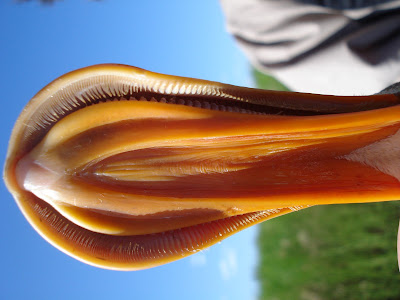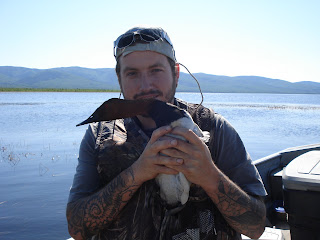
I can't really begin my Alaska tale with out telling you what I did immediately before I left. I work as an environmental educator at Cobbs Creek Community Environmental Education Center in Philadelphia. On May 8th I hosted a group of high school students and led them in a macroinvertebrate identification center. When that was done I headed to school to take my ecology final. I headed home and got ready for the World Series of Birding (WSB). The WSB is a 24 competition where teams compete trying to identify as many species of bird within the state of New Jersey in a 24 hour period. Teams raise money like the Race for the Cure or other charity events, in this case you raise an amount per bird. We raised funds for the American Bird Conservancy. The event started at midnight May 9th.
My team competed in the Carbon Footprint Cup, where you cannot use a motorized vehicle. We used bicycles and had a 90 or so mile route. Our team is called Ridin Birdy and we are sponsored by Kowa Sporting Optics My companions were Matthew Halley, Dan Kubza and Bull Gervasi. Bull is my room mate and former bandmate, he played bass. Matt is my neighbor and is a musician (www.mattheyhalley.org and nicebird.org) and field ornithologist. Dan is in nursing school and has done work for NJ Audubon. Bull served as our mechanic.
We started at Jake's Landing, which is a boat launch in a salt marsh. My roommate Vince drove us to the start. Dan was already down there scouting. Jake's Landing Road goes through pine woods before it goes out into the marsh. We picked up sora, Virginia Rail, whip-poor-will and some other marsh birds that happened to call at night. From there we went to Belleplain State Forest to get barred owl, chuck-wills-widow, and screech owl. Dan got us a campsite and we got two hours of sleep.
We woke up to Arcadian flycatcher and yellow-throated warbler. We hit all the spots in the forest and got most of the birds but missed Louisiana waterthrush but getting bowhite and prothonatary warbler.
In Belleplain we met up with Birding Adventures TV (birdingadventurestv.com) who filmed us throughout the day. The host is a charismatic South African professional bird guide. He passe us in a SUV and said "looks like I caught you riding birdy!".
We also met our competition, Team Dodo, which featured members of NJ Audubon who hosted the event!
From there we headed north despite having to end up at the bottom of New Jersey in Cape May. We wanted to go to Heislerville Wildlife Management Area to pick up salt marsh birds, ducks, gulls and shore birds on the mud flats. To our surprise we ran into Team Dodo at Heislerville, I didn't think another bicycle team would go back north like we did. We figured our advantage was the miles we would put in.
We headed down Route 47 which runs along the Delaware Bay shore and hit a few spots to pick up bald eagle, glossy ibis, surf scoter,royal tern red-headed woodpecker and a few other goodies. We missed gull-billed tern, and blue grosbeak. However we had a coup and Matt found us a black-billed cuckoo! Black-billed cuckoo is considered one of the hardest to see birds in our parts, a true skulker!
We crossed to canal to Cape May proper and hit up Higbee Beach and got our blue-groabeak! We headed to the Cape May Meadows and picked up oystercatcher and piping plover. We headed to the jetties at the point and got common tern our final new bird. We went over to a mudflat area called the "magnesite plant" The bugs were bad and it started to rain so we headed to my favorite cafe in Cape May for a meal. We tried for least bittern afterwards at Cape Island Preserve, but the frogs were so loud we gave up. We headed to the finish line and tapped out. At the finish we were informed by Team Dodo we had vanquished them.
The next day was the award ceremony. It was great to catch up with some friends and folks I rarely see. This was Sunday the next day I was on a plane to Alaska!
















































